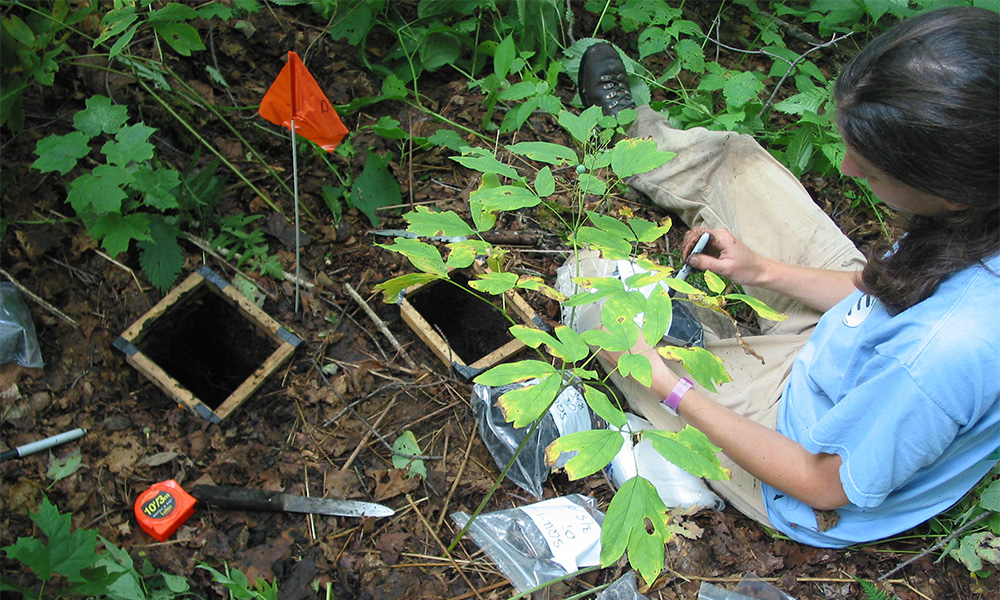How Non-native Earthworms Impact Vermont Forest Soils and Carbon Storage
May. 7th 2025Often seen as a sign of fertile soil and abundant crops, backyard gardeners use earthworms to improve soil health and break down organic matter. However, in forest ecosystems, their impacts can be more complex. Vermont forests, along with other northern forest ecosystems, have evolved without earthworms since the last Ice Age. Non-native earthworms, likely introduced to North America by early European settlers, have been slowly spreading across the region. Their presence is reshaping the forest floor and impacting soil carbon storage, but previous studies differ in their findings leading to uncertainty of what the long-term effects may be.
A recent study from the University of Vermont researchers, led by Dr. Donald Ross, explores the impact of non-native earthworms on forest soils across Vermont. This research highlights how earthworms, especially those introduced from Europe, influence the way carbon is stored in soils. Along with Dr. Josef Gorres, Ross has been studying earthworms in Vermont soils for decades and their research has been covered in ecoNEWS in 2016 and 2021.
“In this study, we used data painstakingly developed by Meghan Knowles, a former M.S. student, detailing soil structure in sites with known worm populations varying between 0–312 individuals per square meter,” shared Ross. “We hypothesized the sites with earthworms present would have more larger aggregates, thus protecting more carbon in the soils.”
Aggregates, as described by Ross, are clumps of soil particles held together by organic matter. To have healthy soils, there should be a combination of small and large aggregates to improve soil structure, provide habitat for microorganisms, and enhance soil fertility. Aggregates are also important because they help "lock in" carbon, keeping it stored in the soil rather than releasing it into the atmosphere.
The study sampled soils from 14 forest sites around Vermont, specifically looking for differences between areas with and without earthworms. At each site, researchers collected soil samples from six plots to a depth of 20 cm to identify the types of soil aggregates and measured the amount of carbon stored within these aggregates. Ten species of earthworms were recorded, of which, nine were of European origin.
In soils with earthworms, there was a higher percentage of large soil clumps, or macroaggregates and fewer ‘free’ smaller aggregates (microaggregates). The larger aggregates are mostly composed of microaggregates and store carbon within them, potentially allowing soils to store more carbon in the long term. However, there seemed to be no overall relationship between soil organic carbon (SOC) and earthworm presence. At sites where there were plots with and without earthworms, the data showed there was a positive relationship with plot SOC concentration and number of earthworm species present, but the site with the highest overall SOC did not have earthworms present.
“In a previous study, we sampled the full soil profile in some of these same plots,” Ross explained. “When we compare those results to this study, it’s clear that sampling only part of the soil can leave out important details. For instance, the site with the lowest soil aggregation in this study actually had the highest total soil organic carbon in the earlier study—most of it stored in the deeper layers.”
While these findings suggest earthworms could help stabilize carbon in the long run by encouraging the formation of macroaggregates, the initial stages of earthworm invasion may result in some carbon loss, and their impacts on forest ecosystems are not limited to soil carbon storage. The effects of the more recently introduced Asian species were not assessed in this study and their long-term impacts are largely unknown.
“We don’t know how long these earthworms have been in these soils, and the impacts of earthworms on soil carbon will likely change over time,” said Ross. “This study provides a short snapshot of the forest soil structure, with potential impacts changing over time.”
 ecoNEWS VT
ecoNEWS VT